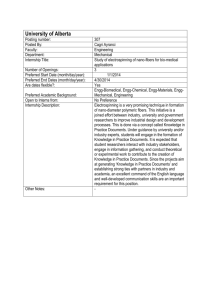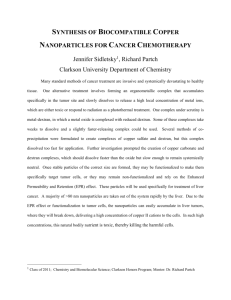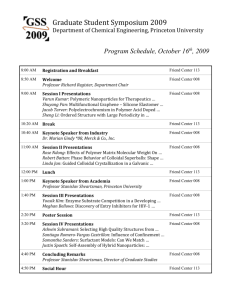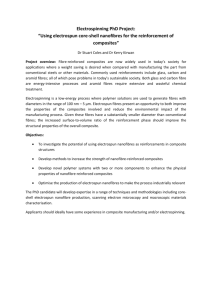Investigating the potential of withered leaves as - aos-hci
advertisement
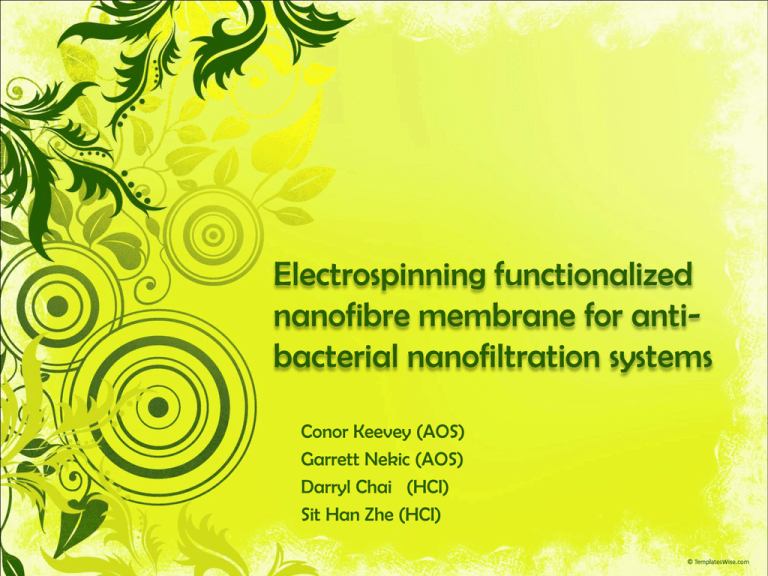
Electrospinning functionalized nanofibre membrane for antibacterial nanofiltration systems Conor Keevey (AOS) Garrett Nekic (AOS) Darryl Chai (HCI) Sit Han Zhe (HCI) Background • Electrospinning is a simple and versatile process that is used to create nanofibre membranes for a variety of applications. • Scientists have implemented various chemicals into the polymer solution to create modified mesh. Background • Copper nanoparticles have shown to possess antimicrobial properties against bacteria such as Escherichia Coli and Bacillus subtilis (Faheem et al, 2011). • Past research has also shown that chlorhexidine digluconate could kill both gram positive and gram negative bacteria (Chen et al., 2008). Rationale Lack of access to drinking water Current conventional methods have their disadvantages: • Non-controllable pore size Lack of ability to control nanofiber composition/ functionalising agents for desired functions • Great demand for a more efficient and cheaper method of water purification. Objectives Confirm the effectiveness of chlorhexidine digluconate and copper nanoparticles electrospun for the log removal of bacteria while integrated in separate nanofibre membranes Determine the effectiveness of a combination of chlorhexidine digluconate and copper nanoparticles electrospun into the same membrane for water purification Hypothesis A combination of copper nanoparticles and chlorhexidine digluconate is more effective than the individual functionalising agents or no functionalising agents when electrospun into nanofibres. Variables Controlled Variables: Ambient measurements, type and amount of bacteria and water, spinning parameters, size of mesh, methods used for filtration and measurements Independent Variable: Type(s) of anti-bacterial agent electrospun with polymer Dependent Variable: The total log removal of colony forming units (CFUs) Materials Acetic acid (18 M glacial) Formic acid (98% concentration) Nylon 6 ([-NH(CH2)5CO-], Sigma Aldrich) Nutrient agar broth Escherichia coli k-12 (ATTC) Bacillus megaterium (ATTC) Sterilised water Bleach Apparatus Electrospinning apparatus Petri dishes Sterile Spreaders Micropipettes AA Spectrophotometer Autoclave Beakers Buchner Funnel Flask Preparation of Copper nanoparticles • Mix copper(II) sulfate with ethylene glycol • Centrifuge mixture to obtain copper nanoparticles • Rinse with distilled water and pat dry with filter paper Preparation of Nanofibres • Dissolve nylon 6 in acetic and formic acid • Mix in antibacterial agent (copper nanoparticles/chlorhexidine digluconate) • Spin an anti-bacterial mesh (Daels et al., 2011) Testing with Bacteria • Grow the Escherichia coli, and Bacillus megaterium using nutrient broth in separate test tubes • Measure and adjust optical density • Mix bacteria with sterilised water • Deposit 100 µL diluted culture into the agar plates (10 plates) Testing with Bacteria • Place mesh on circular plate and fasten to cylinder. Place in funnel • Pour the 500 mL of water through it • Deposit 100 µL of diluted culture onto the agar plates (10 plates) • Place the plates in the incubator http://image.tutorvista.com/content/organic-compounds/filtration-buchner-funnel.jpeg Thank You Bibliography • • • • • • Agarwal, S., Greiner, A., & Wendorff, J. H. (2008). Use of electrospinning technique for biomedical applications. Polymer, 49, 5603-5621. doi: 10.1016/j.polymer.2008.09.014 Bhardwaj, N. & Kundu, S. C. (2010). Electrospinning: A fascinating fiber fabrication technique. Biotechnology Advances, 28, 325-347. doi: 10.1016/j.biotechadv.2010.01.004 Bjorge, D., Daels, N., Devrieze, S. Dejans, P., Camp, T.V., Audenaer, W,... Van Hulle, S. W. H. (2009). Performance assessment of electrospun nanofibers for filter applications. Desalination, 249, 42-948. doi: 10.1016/.j.desal.2009.06.064 Chen, L., Bromberg, L., Hatton, T. A., & Rutledge, G. C. (2008). Electrospun cellulose acetate. Fibers containing chlorhexidine as a bacteriacide. Polymer, 49, 1266-1275. doi: 10.1016/j.polymer.2008.01.003 Daels, N., De Vrieze, S., Sampers, I., Decostere, B., Westbroek, P., Dumoulin, A.,...Van Hulle, S. W. H. (2011). Potential of a functionalised nanofibre microfiltration membrane as an antibacterial water filter. Desalination, 275, 285-290. doi: 10.1016/j.desal.2011.03.012 Faheem, A.S. , Muzafar, A.K. , Saurabah, S, Chung, W.J. & Kim, H (2011). Polyurethane nanofibers containing copper nanoparticles as future materials. Applied Surface Science, 257, 3020-3026 Bibliography • • • • • • • Frey, M. W., & Li, L. (2007). Electrospinning and porosity measurements of nylon6/poly(ethylene oxide) blended nonwovens. Journal of Engineered Fibers and Fabrics, 2, 31-37. Hem, R.P. , Dipendra, R.P. , Ki, T.N. , Baek, W.I. , Seong, T.H. & Kim, H.Y. (2011). Photocatalytic and antibacterial properties of a TiO2/nylon-6 electrospun nanocomposite mat containing silver nanoparticles. Journal of Hazardous Materials, 189, 456-471 Lok, C.N. et al. (2006). Proteomic analysis of the mode of antibacterial action of silver nanoparticles. J Proteomic Research, 5(4): 916-24. Rutledge, G. C. & Fridrikh, S. V. (2007). Formation of fibers by electrospinning. Advanced Drug Delivery Review, 59, 1384-1391. doi: 10.1016/j.addr.2007.04.020 Sondi, I., Salopek-Sondi, B. (2004). Silver nanoparticles as antimicrobial agent: a case study on E. coli as a model for Gram-negative bacteria. Journal of Colloid and Interface Science, 275, 177-182 Y. Dzenis, Science 304 (2004) 1917. Zussman, E., Theron, A. & Yarin, A. L. (2003). Formation of nanofiber crossbars in electrospinning. Appl Phys Let, 82, 973-5.



